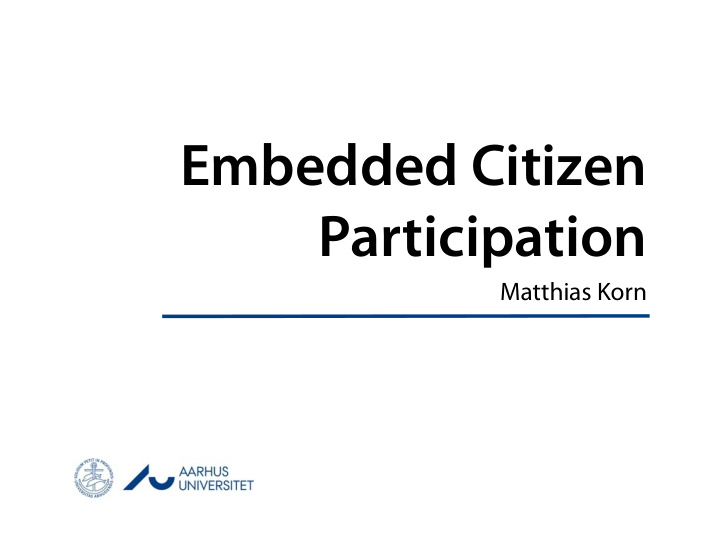



Embedded Citizen Participation Matthias Korn
Citizen Participation
Who will talk?
When will you use it?
Embedded into everyday life!
Agenda ‣ Motivation ‣ Embedded WHAT? ‣ Two Cases ‣ Methodological Challenges ‣ Conclusion
Act I: Embedded WHAT? Banksy
Embedded Citizen Participation • information & participation “on the spot” • “on the spot”: time and place where it makes sense for citizens to engage in the solution of an issue • situatedness: “where you are when you do what you do matters” (Gero, 1998; cf. Clancey, 1997) • decision-making processes bene fi t through • local knowledge and local conditions • real-life impact of interventions
Embedded Citizen Participation • Argyris & Schön (1974): distinction between theory-in-action and espoused theory --> di ff erent views in situ vs. ex situ • Schön (1983): distinction between re fl ection-in-action and o ff -loop re fl ection --> di ff erent results in situ vs. ex situ
In Situ vs. Remote Discussions • in situ discussions: being spatially co-located with the physical object or place that is being negotiated, i.e. citizens are situated in what they discuss about • yet! re fl ection-in-action is not all • citizens are busy & stressed when “on the run” • mobile devices are after all constrained due to their limited capabilities • combination of in situ and remote elements of discussions
Act II: Cases
Case I: Mobile Democracy
Mobile Democracy • Mobile app to engage citizen participation in municipal planning • Citizens suggest changes to the plan or react to proposed changes • Location-aware noti fi cations • Mobile app to take fi rst steps while in the situation • Desktop interface for re fl ection and deeper engagement at home
Augmented Reality City Tour
Augmented Reality City Tour
Augmented Reality City Tour • before participating comes informing • according to the ladder of citizen participation (Arnstein, 1969) • immersive information about the current local environment • displays planned buildings in the local environment on top of a mobile phone’s live camera feed • better understanding of future changes to the cityscape • architectural drawings and textual descriptions often unapt or insu ffi cient to communicate plans to interested residents
Case II: Shaping Mols
Shaping Mols • involving the people living, working or visiting the parks in its development process • citizen participation through mobile social technology that is embedded in their everyday life in the park 1. understanding the nature of citizens’ interest in the process 2. understanding ongoing involvement e ff orts 3. technological interventions in future citizen involvement activities
Act III: Methodology
Studying (Mobile) Situated Use “in the wild” • new challenges & opportunities for methods that are in situ with regards to actual use • technology being embedded into the physical environment or integrated in our everyday life • several relevant workshops • Mobile UX Research @ CHI ‘09 • Observing the Mobile UX @ NordiCHI ‘10 • Research in the Large (App Stores) @ UbiComp ‘10
(1) Contextual Experience Sampling Method • prompt users using your application in their everyday life for input • prompting is triggered depending on various context variables of the use situation • participants report experiences while in the moment • existing examples: MyExperience, CAES
(2) Walkshops • Observing use “in the wild” • Observing sense-making processes of the users • Walkshops enable the study of context paired with the micro-processes of sense-making • Walking as a tool for thinking & closer relation to the context of use • Complementary method for early on in the design process
(2) Walkshops • Observing use “in the wild” • Observing sense-making processes of the users • Walkshops enable the study of context paired with the micro-processes of sense-making • Walking as a tool for thinking & closer relation to the context of use • Complementary method for early on in the design process
Banksy Conclusion
Conclusion Embedded Citizen Participation: • information “on the spot” • participation “on the spot” • in situ & remote discussions • being spatially co-located with the physical object or place that is being negotiated, i.e. citizens are situated in what they discuss about Methodology: studying mobile situated use “in the wild” • methods that are in situ with regards to actual use
Embedded Citizen Participation Matthias Korn mkorn@cs.au.dk http://cs.au.dk/~mkorn
Recommend
More recommend